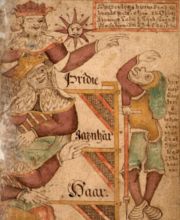
Gylfaginning
Encyclopedia

Gylfi
In Norse mythology, Gylfi, Gylfe, Gylvi, or Gylve was the earliest king in Scandinavia recorded. The traditions on Gylfi deal with how he was tricked by the gods and his relations with the goddess Gefjon.-The creation of Zealand:...
(c. 20,000 words), is the first part of Snorri Sturluson
Snorri Sturluson
Snorri Sturluson was an Icelandic historian, poet, and politician. He was twice elected lawspeaker at the Icelandic parliament, the Althing...
's Prose Edda
Prose Edda
The Prose Edda, also known as the Younger Edda, Snorri's Edda or simply Edda, is an Icelandic collection of four sections interspersed with excerpts from earlier skaldic and Eddic poetry containing tales from Nordic mythology...
after Prologue
Prologue (Prose Edda)
The Prologue is the first section of four books of the Prose Edda, and consists of a euhemerized Christian account of the origins of Norse mythology: the Norse gods are described as human Trojan warriors who left Troy after the fall of that city and settled in northern Europe, where they were...
. The Gylfaginning deals with the creation and destruction of the world of the Norse gods, and many other aspects of Norse mythology
Norse mythology
Norse mythology, a subset of Germanic mythology, is the overall term for the myths, legends and beliefs about supernatural beings of Norse pagans. It flourished prior to the Christianization of Scandinavia, during the Early Middle Ages, and passed into Nordic folklore, with some aspects surviving...
. The second part of the Prose Edda is called the Skáldskaparmál
Skáldskaparmál
The second part of Snorri Sturluson's Prose Edda the Skáldskaparmál or "language of poetry" is effectively a dialogue between the Norse god of the sea, Ægir and Bragi, the god of poetry, in which both Norse mythology and discourse on the nature of poetry are intertwined...
and the third Háttatal
Háttatal
The Háttatal is the last section of the Prose Edda composed by the Icelandic poet, politician, and historian Snorri Sturluson. Using, for the most part, his own compositions, it exemplifies the types of verse forms used in Old Norse poetry...
.
Summary
The Gylfaginning tells the story of Gylfi, a king of "the land that men now call Sweden", who after being tricked by one of the goddesses of the ÆsirÆsir
In Old Norse, áss is the term denoting a member of the principal pantheon in Norse paganism. This pantheon includes Odin, Frigg, Thor, Baldr and Tyr. The second pantheon comprises the Vanir...
, wonders if all Æsir
Æsir
In Old Norse, áss is the term denoting a member of the principal pantheon in Norse paganism. This pantheon includes Odin, Frigg, Thor, Baldr and Tyr. The second pantheon comprises the Vanir...
use magic and tricks for their will to be done. This is why he journeys to Asgard
Asgard
In Norse religion, Asgard is one of the Nine Worlds and is the country or capital city of the Norse Gods surrounded by an incomplete wall attributed to a Hrimthurs riding the stallion Svadilfari, according to Gylfaginning. Valhalla is located within Asgard...
, but on the way he is tricked by the gods and arrives in some other place, where he finds a great palace. Inside the palace he encounters a man who asks Gylfi's name and so king Gylfi introduces himself as Gangleri. Gangleri then is taken to the king of the palace and comes upon three men; High, Just-As-High, and Third
High, Just-As-High, and Third
High, Just-As-High, and Third are three men that respond to questions posed by Gangleri in the Prose Edda book Gylfaginning...
.
Gangleri is then challenged to show his wisdom by asking questions, as is the custom in many Norse sagas. Each question made to High, Just-As-High, and Third is about an aspect of the Norse mythology or its gods, and also about the creation and destruction of the world (Ragnarök
Ragnarök
In Norse mythology, Ragnarök is a series of future events, including a great battle foretold to ultimately result in the death of a number of major figures , the occurrence of various natural disasters, and the subsequent submersion of the world in water...
). In the end all the palace and its people just vanish and Gylfi is left standing on empty ground. It is then implied that as Gylfi returns to his nation, he retells the tales he was told. It can be argued that Snorri used this narrative device as a means of being able to safely document a vanishing and largely oral tradition within a Christian
Christian
A Christian is a person who adheres to Christianity, an Abrahamic, monotheistic religion based on the life and teachings of Jesus of Nazareth as recorded in the Canonical gospels and the letters of the New Testament...
context.
External links
- Gylfaginning in Old Norse at heimskringla.no
- Text of all original manuscripts
- The text with modern Icelandic spelling
- English translation
- CyberSamurai Encyclopedia of Norse Mythology: Prose Edda - Gylfaginning (English)
- CyberSamurai Encyclopedia of Norse Mythology: Prose Edda - Gylfaginning (Old Norse)

